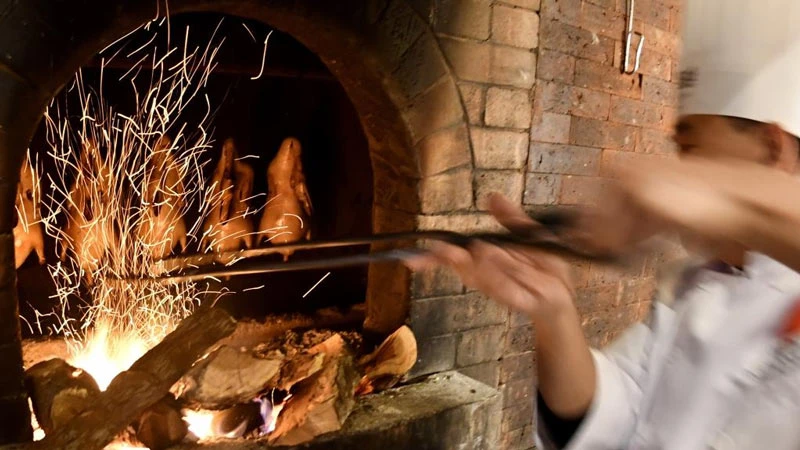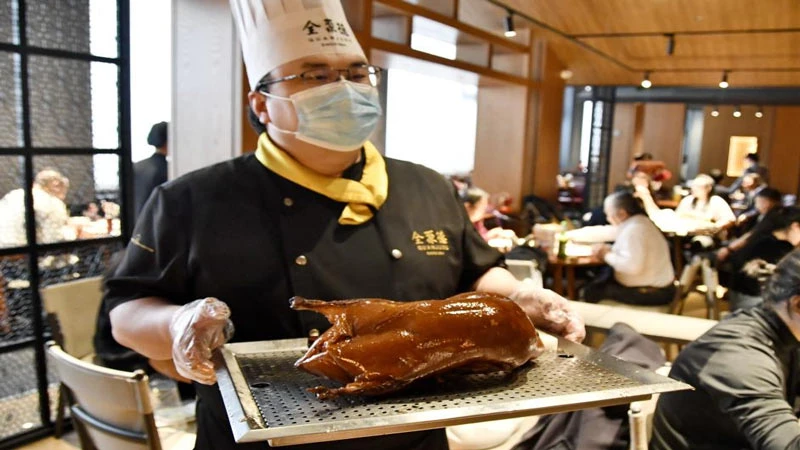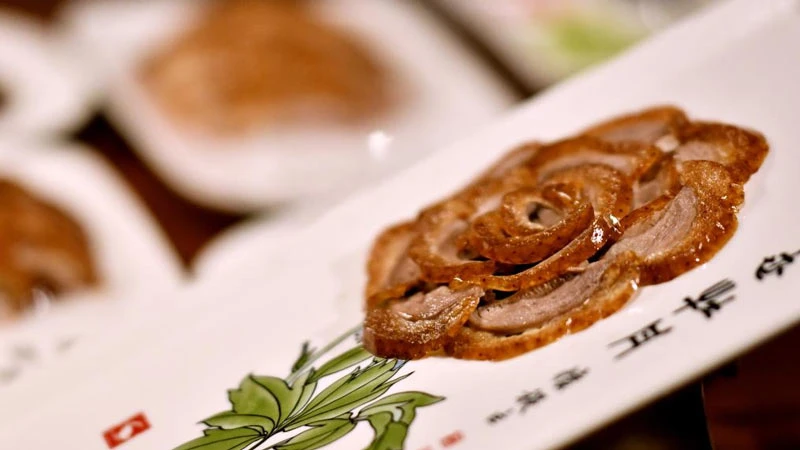In the heart of Beijing, where ancient Hutongs whisper tales of dynasties past, a culinary masterpiece has been perfected over 160 years—not in the quietude of a scholar's study, but in the roaring flames of a hanging oven. Quanjude (全聚德) Peking Duck, a dish synonymous with imperial grandeur and modern ingenuity. Since its founding in 1864 by Yang Quanren, a visionary duck vendor from Hebei, Quanjude has transformed the humble duck into a cultural icon, its roasting technique enshrined in 2008 as a National Intangible Cultural Heritage.
Yang's genius lay not merely in recipe, but in ritual. Passing through seven generations of masters—each apprenticed in the sacred fires of the oven—the art of Quanjude's hanging-oven roasting (挂炉烤鸭技艺) has endured wars, revolutions, and the frenetic pulse of globalization. Today, as the aroma of applewood-smoked duck wafts through its doors, Quanjude stands as both guardian and innovator: a ¥1 billion-a-year empire straddling tradition and modernity.
How to Handle Crisp and Tenderness
To witness a Quanjude chef at work is to observe a choreography as precise as calligraphy. The creation of a perfect Peking duck unfolds in two acts: zhì bēi (制坯, crafting the blank canvas) and kǎo zhì (烤炙, the baptism by fire).
- Act I: Slaughter to Sculpture
The journey begins with the Beijing Fat Duck, a breed elevated to royalty through centuries of selective rearing. Unlike free-range fowl, these ducks are pampered with scientifically calibrated diets and low-stress environments, their plump bodies destined for transcendence.
A 13-step ritual transforms the duck into a taut, air-inflated vessel. After scalding, plucking, and evisceration, the carcass is propped open with a wooden crossbar, rinsed, and hung to dry.
The skin, brushed with maltose syrup, undergoes two rounds of drying and a final scalding with boiling water—a process that ensures the iconic crimson-gold lacquer finish.
- Act II: The Inferno's Kiss
Here, the hanging oven—a brick kiln with an open mouth, refusing thermometers or timers—becomes a stage. Hardwood flames (apple, pear, or jujube) crackle as the chef, armed with a 2-meter pole, dances with physics and intuition:
The boiling water infusion into the duck's cavity creates a "simmer within, inferno without" Baptism:
Block the vent, rotate, singe the thighs, pivot—each movement timed to the wood's whisper. Forty minutes later, the duck emerges: skin crackling like Ming porcelain, meat steeped in fruitwood incense.
"It's not cooking," says fifth-generation master Zhang Lifeng. "It's conversing with fire."
From Imperial Kitchens to Gen Z's Feed
In 1993, as China's reform era surged, Quanjude shed its single-rooftop identity to form a conglomerate. By 1994, it had embraced shareholding, launching franchises from Shanghai to Los Angeles. Yet its true metamorphosis began in the 2020s, when this 160-year-old phoenix turned to an unlikely ally: youth culture.
Faced with a graying clientele, Quanjude's marketers unleashed a "Youthful Leap":
Collaborations with bubble tea brands birthed creations like "Duck Fat Boba" (swiftly retracted, but viral nonetheless). TikTok tutorials demystified pancake-rolling, while Douyin livestreams showcased chefs as rockstar artisans.
Behind the hashtags lies a deeper strategy: dual-engine growth. While flagship stores preserve the ceremonial duck-carving theater (complete with chef's white gloves and silk banners), Quanjude's food labs churn out vacuum-packed roast duck for e-commerce, and its cultural arm designs duck-shaped porcelain teapots. Even the ovens have evolved—hybrid models now blend fruitwood with AI temperature sensors, ensuring consistency across continents.
A Traveler's Guide to Savoring Quanjude
For gastronomes, a trip to Beijing isn't complete without a pilgrimage to Quanjude.
Where to Go:
Begin at the Qianmen Quanjude Roast Duck Restaurant (32 Qianmen Street). Established in 1864, this three-story institution is a living museum. Reserve a window seat overlooking the historic street, where rickshaws still clatter past.
For a sleek twist, visit the Quanjude Olympic Park Branch, its glass-walled kitchens offering a theatrical view of chefs wielding their duck poles like samurai swords.
When to Visit:
Avoid the Rush: Lunch crowds peak at 12:30 PM; arrive by 11:15 AM for a serene start. Evening slots (5:30–6:00 PM) offer golden-hour ambiance.
Festive Caution: Skip Chinese National Day (Oct 1–7) and Spring Festival—waits can exceed three hours.
Order Like a Pro:
A whole duck (¥268–¥398) serves 2–3. Insist on "yīyā sān chī" (一鸭三吃): crispy skin dipped in sugar, succulent meat wrapped in pancakes, and a broth made from the bones.
Balance richness with pickled radish shreds (解腻萝卜丝) and fried duck liver (炸鸭肝), a lesser-known delicacy. Skip the overpriced wine—opt for Jasmine Tea (茉莉花茶) to cleanse the palate.
Insider Hack: After your meal, request a "Duck Calligraphy Certificate"—a novelty slip noting your duck's serial number, a quirky souvenir.
"The best roast duck isn't on the plate—it's in the journey to find it." As the eighth generation of oven masters train alongside AI engineers, one truth remains: greatness, like a perfect duck skin, is forged only in the union of heat and time.




